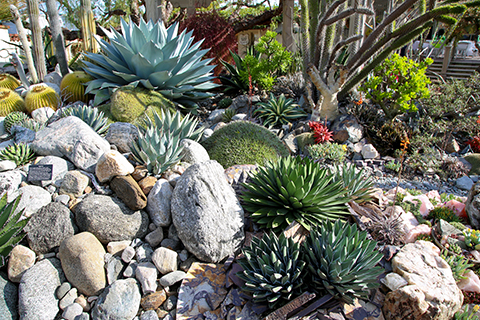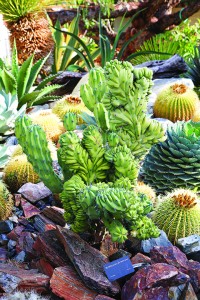Orange County’s nature preserves beckon with stunning scenery and the vibrant colors of summer.
By Sharael Kolberg
With summer in full bloom, it is worth wandering through some of the bespoke gardens that Orange County has to offer. An abundance of local flora and fauna await exploration at the region’s many park-like retreats, ranging from expansive preserves to hidden gems nestled amid the cityscape, providing an escape for every palate.
Whether it’s California native plants growing in the coastal canyons of Laguna Beach, afternoon tea in a manicured urban garden in Corona del Mar, more than 20 aces of diverse plants in a university setting in Fullerton or views of Saddleback Mountain from a hilly preserve in Laguna Niguel, there are plenty of settings to lure visitors outdoors to enjoy the season’s beauty.
A Historical Sanctuary
The Hortense Miller Garden in Laguna Beach features 2.5 acres of gardens and hiking trails in Boat Canyon. The area includes a diverse array of flora, such as perennials, succulents and native coastal sage scrub typical in Southern California. Terri Johnson, president of the Friends of the Hortense Miller Garden, a nonprofit dedicated to preserving the garden, notes that the grounds are natural, not manicured. The property also includes the former home of Hortense Miller, who lived there from 1959 until about 2007, before her death in 2008, just weeks before her 100th birthday. Miller spent much time admiring and observing her garden. In 1999, she wrote the following in a Friends of the Hortense Miller Garden newsletter: “Once you interfere with the native growth by planting a garden, it’s easy at first and then it becomes increasingly difficult to keep up with it. No wonder most old gardens are not much more than the conquering tree and a patch of poor grass.”
Miller loved the outdoors and that is reflected in her home design, from the bedroom with a view of a pond where animals drink, to the bathroom that looks onto an atrium, and the kitchen surrounded by windows instead of walls. The north side of the home is all windows, offering a stunning view of Boat Canyon and the Pacific Ocean. The home features many open-air portions, which allow the salty ocean breeze and the garden’s earthy scents to waft inside. 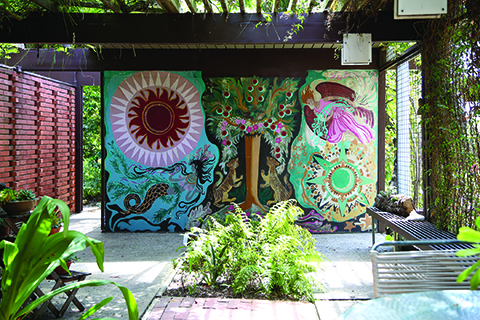
The original furnishings are kept as she left them, reflecting the midcentury modern design that was popular in the 1960s and 1970s. The space also preserves her passion for art, including several wall murals she painted. According to docent Dorothea Yellott, when Miller wasn’t in her garden, she enjoyed spending her spare time doing arts and crafts, such as painting, woodcarving, embroidery and writing. In fact, two of her books of essays have been published. “She was a very innovative gardener … [but also] had an interest in nature, science and history,” Yellott says.
The Friends of the Hortense Miller Garden raises funds to pay for upkeep of the home and gardens. “[The] friends are committed to keeping Hortense’s vision alive,” Johnson says. “When doing any renovations, we ask ourselves, ‘What would Hortense want?’ ”
A Quaint Garden Retreat
Sherman Library & Gardens in Corona del Mar—encompassing 2.2 acres of gardens with plants from around the globe—showcases many Mediterranean varieties and some rare species.
The former plant nursery was purchased and turned into a garden by Arnold Haskell, who named the property after his mentor, Moses H. Sherman, the developer and namesake of Sherman Oaks, a community in the San Fernando Valley. The garden was designed to be a cultural center for Orange County. “He wanted it to be a place for people to connect; a public area for them to come in and enjoy,” says garden director Scott LaFleur.
Located in an urban setting, right off Pacific Coast Highway, the property takes up one city block and feels more like a well-manicured yard than a typical public garden. “It is a lot to see, packed into a very small space,” LaFleur says. “The gardens, which opened in 1966, showcase an old style of California gardens. It’s as if you’re being transported to a different time and place.”
The property includes cactus and succulents; a tropical conservatory with an orchid collection and koi pond; a rose garden with more than 27 varieties; a fern and cycad (palm-like tropical plants) grotto; a Japanese and native California garden; a bromeliad garden and shade garden with more than 80 begonias; and a sun garden with annuals and perennials.
Guests are welcome to wander through the property and take in an abundance of the beautiful variety of plants and flowers, water features and artistic sculptures, or utilize the grounds for research and inspiration for their own backyards. In fact, LaFleur’s favorite spot is the succulent garden designed by Matt Maggio. “It is a piece of art unto itself,” he says.
While visiting the gardens, guests can also opt to dine alfresco at Cafe Jardin during the week or for Sunday brunch; or at the Tea Garden Creperie on the weekends. On the last Wednesday of the month, an afternoon tea is also offered.
And, as if the gardens aren’t interesting enough, the property also includes a research library in an original adobe house. Here, visitors will find nearly 25,000 books and other research materials related to the history and development of the Pacific Southwest; microfilm reels include old issues of the Los Angeles Times dating back to its 1881 beginnings.
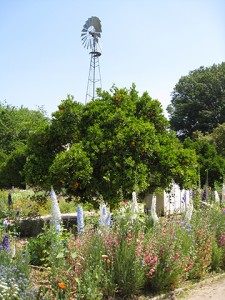 University in Bloom
University in Bloom
Fullerton Arboretum, the largest botanical garden in Orange County, features more than 4,000 plants from around the world situated on 26 acres at California State University, Fullerton. Visitors will delight in spending an hour or an entire day strolling the grounds and discovering the various types of plants as well as ponds, streams and wildlife.
Since the gardens opened in 1979, the mission has focused on education, conservation and research. “The arboretum is open to anyone—visitors, residents, kindergarten-through-graduate students—who wants to gain knowledge and appreciation of the plant world,” says Fullerton Arboretum Director Greg Dyment. “We promote stewardship and plant diversity and feature plants that use little water.”
It’s also a place for visitors and locals alike to reconnect with nature. As Dyment says, “The arboretum was started because people didn’t want to lose the connection to the land, especially now that the area is full of strip malls, asphalt and tract homes.”
The arboretum is divided into four collections with 26 sub-collections, allowing visitors to travel from the tropical rainforests of Madagascar to the redwoods of Northern California, all in the matter of hours.
Stretching the length of the arboretum, the Woodlands Collection ranges from conifers to palms, a deciduous forest, living fossils, redwoods, ombu (a fast-growing evergreen tree in South America), figs and cycads (palm-like tropical plants dating back to the Jurassic Period). The Desert Collection features cactus and agave plants while the Mediterranean Collection includes chaparral and Channel Islands plants—the only place these plants can be seen outside of the islands.
Rounding out the arboretum, the Cultivated Collection includes rare fruits, an herb garden, roses and citrus, as well as the Heritage House, a restored 19th-century Victorian home. Also in this section: a children’s garden, which invites youngsters to use their senses to explore the sight, scent and texture of various plants. Children will also love visiting the nature center to use spotting scopes and check out display cases with animals, bugs and flowers.
It’s also worth visiting the rotating exhibits at the Orange County Agricultural and Nikkei Heritage Museum. This summer, graduate students will turn arboretum plants into instruments that will be displayed. Before heading home, be sure to stop by the potting shed nursery to purchase a plant to take home and enjoy.
In fact, a perennial token from the university’s garden is a perfect reminder to stop and smell the roses this summer.
Preserving the Land
Hidden behind the Laguna Niguel Family YMCA and community pool off Crown Valley Parkway is the Niguel Botanical Preserve, part of the Crown Valley Community Park. This 18-acre preserve, established as a nonprofit organization in 1984, includes plants from regions with Mediterranean climates such as Australia, Africa, South America, the Mediterranean, Mexico and parts of California including Orange County.
“The preserve is unique because of the hilly terrain and vistas of Saddleback Mountain,” says Monty McDivitt, president of the board of directors. “It is a preserve, not a garden. It has a natural feeling when walking through it.”
The space includes cactus and succulent displays; an evergreen forest of pine and oak trees offering shady respite; a community rose garden; eucalyptus savanna; palm trees from around the globe; and a 200-seat grass amphitheater. Kids will love exploring the maze and fort in the children’s garden while young and old alike will enjoy a meditative walk through a labyrinth made of sandstone- and gray-colored pavers with a central mosaic of three red bougainvillea flowers hand-sculpted by artist Marty Kermeen.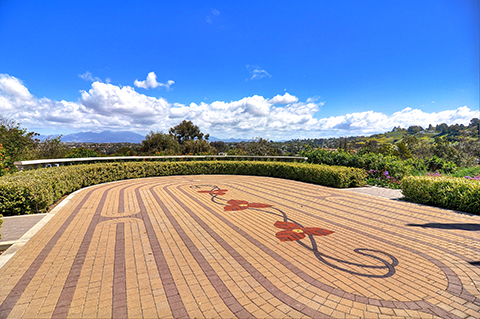
The labyrinth sits atop a commemorative Citizen of the Year Grove—a brick path lined with crepe myrtle and plaques honoring each of Laguna Niguel’s residents who have won dating back to 1989. Meanwhile, the City Bougainvillea Grove represents the city’s official flower. The Girl Scout Canyon, filled with beautiful purple-blooming jacarandas, shows off the city’s official tree. In this serene setting, which has become a haven for local wildlife, butterflies can often be found flitting from flower to flower while squirrels scamper about in the various sections. Butterfly sculptures add an artistic touch amid the flora and fauna.
McDivitt says the preserve started out as a community vegetable garden in 1981, but participants became discouraged because rabbits kept eating what was planted. Since then, the focus has turned to plants with low water needs, providing an example of drought-tolerant landscaping for visitors to use in their own gardens. Maintained through volunteer efforts, the preserve’s partners have included numerous individuals as well as local youth and community groups, schools, churches and businesses. Their dedication, which helps maintain the grounds for generations to enjoy time and again, is showcased in this thriving preserve.
However Orange County visitors choose to spend their time, a stop at one of the region’s many natural treasures is not only a great way to spend a summer afternoon but also get to know Southern California’s unique habitat.

